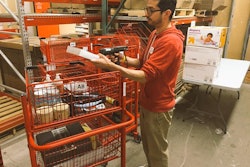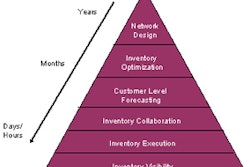The Council of Supply Chain Management Professionals (CSCMP) uses the following words to define Logistics and the related management activities involved with the process: "Logistics is that part of the supply chain process that plans, implements and controls the efficient, effective forward and reverse flow and storage of goods, services, and related information from the point of origin to the point of consumption in order to meet customers' requirements. Logistics management activities typically include inbound and outbound transportation management, fleet management, warehousing, materials handling, order fulfillment, logistics network design, inventory management, supply/demand planning, and management of third-party logistics providers."
This definition implies that logistics is a complex, multi-faceted topic, and one that, for leaders in business today, cannot be ignored.
Historically, logistics has been considered to be the "back end" of an operation, a necessary cost, after everything else in a fulfillment initiative has been decided. The important aspects of the activity have been determined — all the conceptualizing, the creative work, the database management and the overall strategic thinking. At this point, anyone can handle the distribution. Right? Wrong.
The Turning Point
Less-than-stellar distribution processes during the dot-com era brought distribution to the forefront as a vital function. The industry's perception of this function was further altered because of an increasingly technologically oriented marketplace and the realization that distribution is indeed a place where strategic imperatives, such as brand building, maintaining a relationship and driving out costs, can be achieved. And although this recognition may have come because of the impact and negative impressions left on consumers, the exact same concerns can be applied to a business-to-business audience as well.
Astute marketers now consider distribution to be just as important as any other component of a marketing initiative. An obvious example of this is that the Internet has been incorporated into distribution processes, resulting in strategic, or integrated, fulfillment systems.
Distribution has also evolved from a strictly "push" model to include a "pull" process as well. The push method is the traditional approach to distribution, which relies on anticipating and calculating needs of an intended audience, determining a schedule for distribution and then executing a process based on this information. It typically involves gathering the names of recipients, performing some database work, maintaining an inventory of items to be distributed, and packing and shipping in a somewhat routine way.
A pull system, on the other hand, requires eligible users — dealers, retailers or sales representatives, for example — from various locations to log in to a central Internet portal and select materials or items that they want. These items are then fulfilled upon request. From a technology perspective, the pull process is more complex, involving the development of a central Web site, or "electronic store." The site features a searchable catalog with descriptions and photos of each item, quantity in stock and the cost, if applicable. Components of the process include: an inventory of materials to be distributed, electronic files of materials to be produced on demand, on-site digital print resources for immediate production, and packing and shipping. Depending on whether a requestor of items assumes the cost of materials, there may be a billing process established by the manufacturer.
Advantages of Each
While the push and pull methods each have their benefits, for companies the preferred distribution scenario may be a blending of the two methods, depending on the actual items or materials that need to be distributed, the expense of the materials, the time frame needed for replenishment and the actual distribution processes established.
In addition other forces that can impact the method used include global delivery requirements, customer expectations, production flexibility, cycle time and financial implications. The highlights of each are as follows:
Push distribution
- Provides materials without any action on the part of the recipient
- Distribution is based on pre-established parameters
- Distribution is according to a pre-planned schedule that anticipates needs
- Potential of burdening recipients with excessive quantities of certain items while "going short" in others
- Lacks the flexibility to respond to dynamic changes in marketplace needs
- Generally requires an extensive inventory of materials
Pull distribution
- Responsibility is put on the intended recipient to define requirements
- Recipients receive the support that is needed
- Process uses information from the point of sale in a strategic manner
- Provides materials "on demand" in response to a request
- Does not require maintaining excess inventories; generally involves print on demand
- Success depends on ability of the system to react
Taking it a step further, a pull scenario can lay the groundwork for the electronic storage, retrieval and archival of information and documents. This makes it easier to ensure the current version of materials can be produced and sent to an audience at all times.
Essential Components
In order to be strategic with distribution processes, an organization has to pay particular attention to both the functional elements of a distribution process and the personnel who are assigned to execute the task. Both "push" and "pull" require elements of each, although specifics may vary.
First, a strong information technology component is essential. In a push scenario it is needed for the traditional inventory management function as well as the manipulation of shipping files; in a pull scenario it is needed for the creation of a Web site and the on-demand production capabilities that may be needed. Depending, too, on the content of the packages that need to be fulfilled and the required personalization, the IT function may be needed here as well.
Second, formal processes are vital whether considering push or pull distribution in order to ensure consistency, timeliness and accuracy. The processes, however, may be more complex in a pull scenario when a more multi-faceted approach that includes the Web component, the production function and fulfillment is taken.
Third, complementary production equipment is needed in order to ensure quick turnaround fulfillment of materials being requested. This is especially essential in order to maintain the credibility of the pull process, which requires on-demand production of items requested. In an ideal world, one organization or outsourcer would handle all phases of the workflow, including pre-fulfillment creative design, contact center support, and finishing and assembly work.
And finally, the impact of the personnel cannot be minimized. With the recognition that distribution is strategic, the staff called on to execute this function must not only have the training and required skills to perform the work but understand the process in its entirety in order to ensure successful execution. With the pull method, too, unlike in the past, computer skills are essential, which takes this competency to a new level.
The world of distribution has changed for good and, in the estimation of most, not only to the advantage of the recipient of the communications but to the benefit of the sender as well. No longer is the distribution process considered a "back end" necessity. It is considered an integral and strategic component. In the B2B world it is especially critical since intermediary channels — the dealers, the retailers, the representatives, the outlets — are essential to supporting the end user customer. Communications with these audiences must be consistent, available and correct. This makes it especially critical to think strategically about how we get them there and what is communicated in the process.
About the Author: Bruce Mason, is an 18-year veteran of Budco, a marketing services and distribution company headquartered in Highland Park, Mich., just outside of Detroit. He has worked with clients as diverse as Allied Domecq Spirits, DaimlerChrysler Corp., Disney, Ford Motor Co., Johnson & Johnson, and TAP Pharmaceutical, helping them reduce costs, generate revenue and enhance loyalty by applying creative, strategic approaches to their logistics processes.

















![Pros To Know 2026 [color]](https://img.sdcexec.com/mindful/acbm/workspaces/default/uploads/2025/08/prostoknow-2026-color.mduFvhpgMk.png?ar=16%3A9&auto=format%2Ccompress&bg=fff&fill-color=fff&fit=fill&h=135&q=70&w=240)

